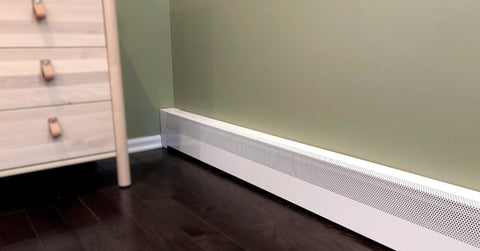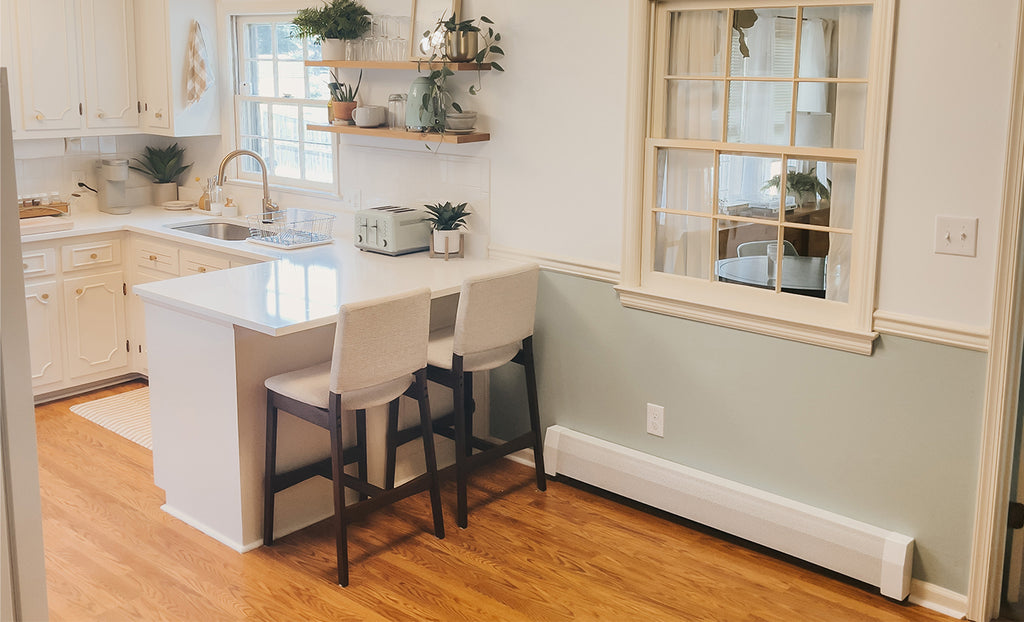Hot Water Baseboard Heater Basics

Hot water is used as an energy-transporting medium to heat homes in many cold climates around the world today.
When heated water runs through finned tube element installed where the wall and floor intersect, it's called hot water baseboard heating, or hydronic baseboard heaters.
Let's take a look at hot water baseboard heaters and their particular renovation needs and unique features.

The Basics
First, these aren't electric baseboard heaters. Unlike the all-in-one electric baseboard heaters that just plug in, hydronic heating is a system of various components that are very much behind the scenes. The process starts with a boiler that brings water to a temperature of around 180F.
A circulation pump then moves this water in a pressurized closed loop of copper or PEX piping throughout the house. While most of this heating system runs through floor joists and wall studs, the baseboard heater is where all the action is.
The pipe carrying the hot water is exposed in the room at baseboard level. It is surrounded by metal fins, called a finned tube element, that help translate the heat into the air of the room. Air currents in the room move the hot air up to create a convection-like action.
This whole system is covered by the baseboard heater cover, which has slots or openings that allow for air circulation.

Form vs Function
Hot water baseboard heating has traditionally been about the function rather than form. Thus, baseboard heat is not known as the prettiest option for heating. Not only do baseboard heaters have a reputation for being ugly, they also pose problems for the placement of furnishings and drapery around them.
That's where Baseboarders® comes in. We've put design first. Easy slip-on Baseboarders offer a quick and effective solution to the visible part of a hydronic baseboard heating system.
We considered at least two major issues that have plagued homeowners with baseboard heat:
- The backplate of a baseboard heater is permanent, making it a major undertaking to replace the covers.
- The look is notoriously clunky and outdated.
The solution to both of these issues was simple, make a nice-looking cover that's easy to install. So that's just what we did.
Baseboarders are designed to retrofit on to the existing back plate by slipping over the existing backplate and "guts" of the heater. We also created four designs and four colors to amp up the look of the covers.
The covers literally take a few minutes per unit to replace. Simply remove the end caps, pull the old cover off, slide the new cover onto the existing backplate, and place new end caps. Simple as that!
See How to Install Baseboarders

DIY Maintenance
With air circulation being what makes baseboard heat work, dust bunnies and other fluff will eventually build up inside the heater enclosure. These accumulations of foreign material can and will disrupt the airflow around the element.
It's important that the finned tube element be vacuumed out on an annual basis. During the summer or heading into fall is the perfect time to do this. Simply remove end caps and the cover, vacuum, then replace cover and caps.
It's a good idea to do quick cleaning throughout the heating season as well. Just vacuum the exterior of the baseboard heater cover. You can wipe down and dry the exterior of the cover also.
Baseboarders are powder coated for ultimate durability and longevity. This makes them rust resistant and easy to clean.
See How to Clean Baseboard Heaters Yourself

Heaters as Attractive Architectural Details
Baseboarders are designed with the intention of transforming unattractive hot water baseboard heaters into something much more visually appealing. The easy slip-on concept breathes new life into a system that is often thought of as outdated. With the option to update the covers so easily, baseboard heat is viable again, both as a heating system and a design element.
Consider the Elliptus cover. The curved front surface introduces a more modern style never before seen. Premium covers are discreet yet dignified. With the choice of several colors, you can stop worrying about what to do with your baseboard heaters.
